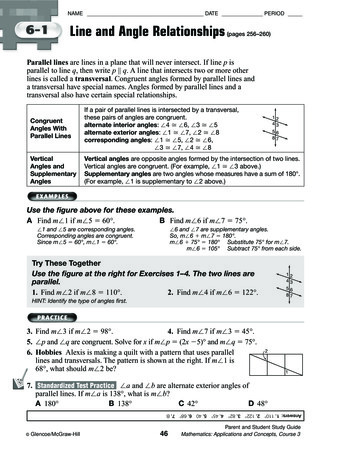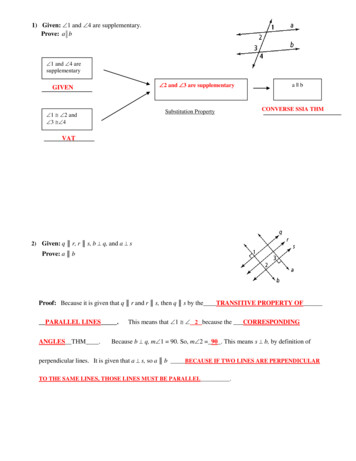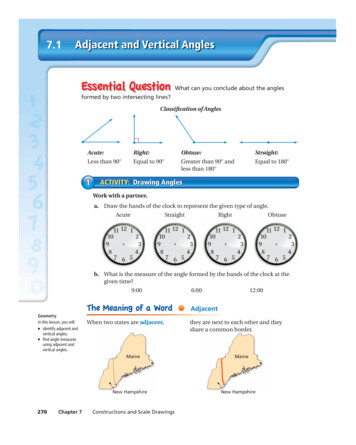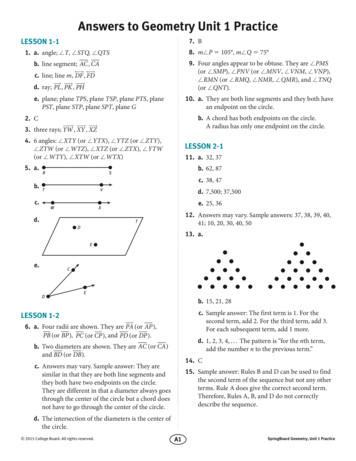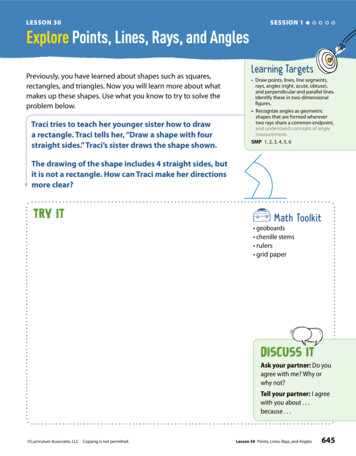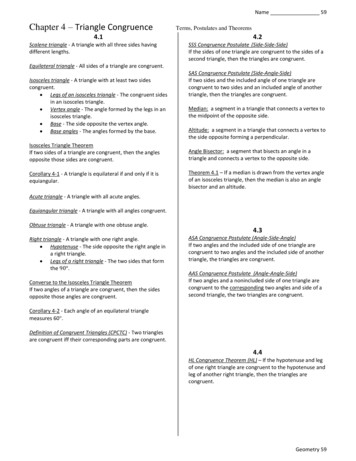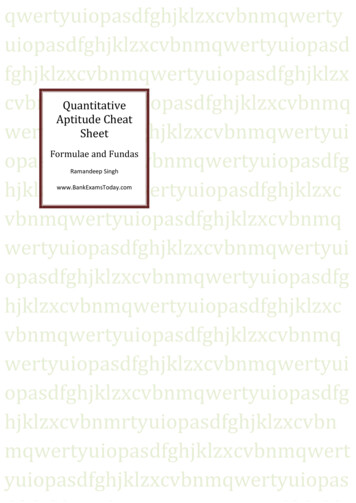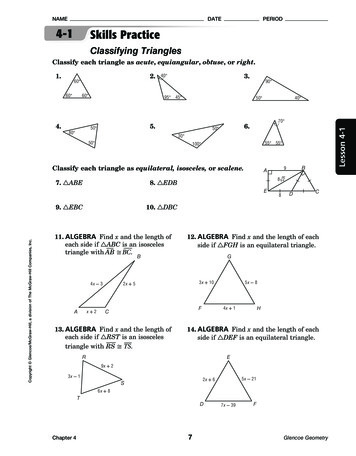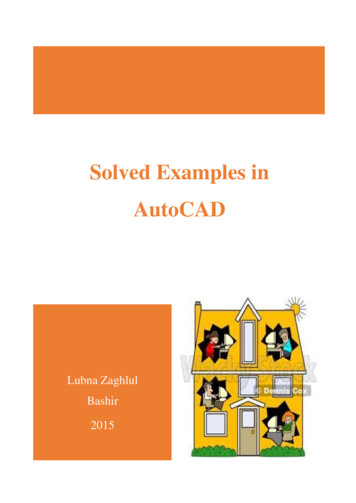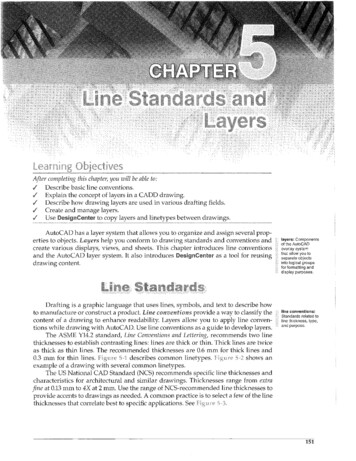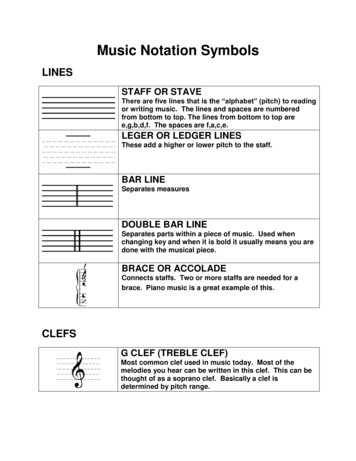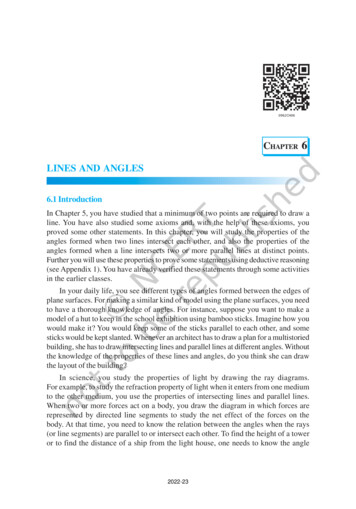
Transcription
CHAPTER 6LINES AND ANGLES6.1 IntroductionIn Chapter 5, you have studied that a minimum of two points are required to draw aline. You have also studied some axioms and, with the help of these axioms, youproved some other statements. In this chapter, you will study the properties of theangles formed when two lines intersect each other, and also the properties of theangles formed when a line intersects two or more parallel lines at distinct points.Further you will use these properties to prove some statements using deductive reasoning(see Appendix 1). You have already verified these statements through some activitiesin the earlier classes.In your daily life, you see different types of angles formed between the edges ofplane surfaces. For making a similar kind of model using the plane surfaces, you needto have a thorough knowledge of angles. For instance, suppose you want to make amodel of a hut to keep in the school exhibition using bamboo sticks. Imagine how youwould make it? You would keep some of the sticks parallel to each other, and somesticks would be kept slanted. Whenever an architect has to draw a plan for a multistoriedbuilding, she has to draw intersecting lines and parallel lines at different angles. Withoutthe knowledge of the properties of these lines and angles, do you think she can drawthe layout of the building?In science, you study the properties of light by drawing the ray diagrams.For example, to study the refraction property of light when it enters from one mediumto the other medium, you use the properties of intersecting lines and parallel lines.When two or more forces act on a body, you draw the diagram in which forces arerepresented by directed line segments to study the net effect of the forces on thebody. At that time, you need to know the relation between the angles when the rays(or line segments) are parallel to or intersect each other. To find the height of a toweror to find the distance of a ship from the light house, one needs to know the angle2022-23
90MATHEMATICSformed between the horizontal and the line of sight. Plenty of other examples can begiven where lines and angles are used. In the subsequent chapters of geometry, youwill be using these properties of lines and angles to deduce more and more usefulproperties.Let us first revise the terms and definitions related to lines and angles learnt inearlier classes.6.2 Basic Terms and DefinitionsRecall that a part (or portion) of a line with two end points is called a line-segmentand a part of a line with one end point is called a ray. Note that the line segment AB is denoted by AB , and its length is denoted by AB. The ray AB is denoted by AB , and a line is denoted by AB . However, we will not use these symbols, and will denotethe line segment AB, ray AB, length AB and line AB by the same symbol, AB. Themeaning will be clear from the context. Sometimes small letters l, m, n, etc. will beused to denote lines.If three or more points lie on the same line, they are called collinear points;otherwise they are called non-collinear points.Recall that an angle is formed when two rays originate from the same end point.The rays making an angle are called the arms of the angle and the end point is calledthe vertex of the angle. You have studied different types of angles, such as acuteangle, right angle, obtuse angle, straight angle and reflex angle in earlier classes(see Fig. 6.1).(i) acute angle : 0 x 90 (ii) right angle : y 90 (iii) obtuse angle : 90 z 180 (v) reflex angle : 180 t 360 (iv) straight angle : s 180 Fig. 6.1 : Types of Angles2022-23
LINES AND ANGLES91An acute angle measures between 0 and 90 , whereas a right angle is exactlyequal to 90 . An angle greater than 90 but less than 180 is called an obtuse angle.Also, recall that a straight angle is equal to 180 . An angle which is greater than 180 but less than 360 is called a reflex angle. Further, two angles whose sum is 90 arecalled complementary angles, and two angles whose sum is 180 are calledsupplementary angles.You have also studied about adjacent anglesin the earlier classes (see Fig. 6.2). Two anglesare adjacent, if they have a common vertex, acommon arm and their non-common arms areon different sides of the common arm. InFig. 6.2, ABD and DBC are adjacentangles. Ray BD is their common arm and pointB is their common vertex. Ray BA and ray BCare non common arms. Moreover, when twoangles are adjacent, then their sum is alwaysequal to the angle formed by the two noncommon arms. So, we can writeFig. 6.2 : Adjacent angles ABC ABD DBC.Note that ABC and ABD are notadjacent angles. Why? Because their noncommon arms BD and BC lie on the same sideof the common arm BA.If the non-common arms BA and BC inFig. 6.2, form a line then it will look like Fig. 6.3.In this case, ABD and DBC are calledlinear pair of angles.Fig. 6.3 : Linear pair of anglesYou may also recall the vertically oppositeangles formed when two lines, say AB and CD,intersect each other, say at the point O(see Fig. 6.4). There are two pairs of verticallyopposite angles.One pair is AOD and BOC. Can youfind the other pair?Fig. 6.4 : Vertically oppositeangles2022-23
92MATHEMATICS6.3 Intersecting Lines and Non-intersecting LinesDraw two different lines PQ and RS on a paper. You will see that you can draw themin two different ways as shown in Fig. 6.5 (i) and Fig. 6.5 (ii).(i) Intersecting lines(ii) Non-intersecting (parallel) linesFig. 6.5 : Different ways of drawing two linesRecall the notion of a line, that it extends indefinitely in both directions. Lines PQand RS in Fig. 6.5 (i) are intersecting lines and in Fig. 6.5 (ii) are parallel lines. Notethat the lengths of the common perpendiculars at different points on these parallellines is the same. This equal length is called the distance between two parallel lines.6.4 Pairs of AnglesIn Section 6.2, you have learnt the definitions ofsome of the pairs of angles such ascomplementary angles, supplementary angles,adjacent angles, linear pair of angles, etc. Canyou think of some relations between theseangles? Now, let us find out the relation betweenthe angles formed when a ray stands on a line.Draw a figure in which a ray stands on a line asshown in Fig. 6.6. Name the line as AB and theray as OC. What are the angles formed at thepoint O? They are AOC, BOC and AOB.Fig. 6.6 : Linear pair of anglesCan we write AOC BOC AOB?(1)Yes! (Why? Refer to adjacent angles in Section 6.2)What is the measure of AOB? It is 180 .(Why?)From (1) and (2), can you say that AOC BOC 180 ? Yes! (Why?)From the above discussion, we can state the following Axiom:2022-23(2)
LINES AND ANGLES93Axiom 6.1 : If a ray stands on a line, then the sum of two adjacent angles soformed is 180 .Recall that when the sum of two adjacent angles is 180 , then they are called alinear pair of angles.In Axiom 6.1, it is given that ‘a ray stands on a line’. From this ‘given’, we haveconcluded that ‘the sum of two adjacent angles so formed is 180 ’. Can we writeAxiom 6.1 the other way? That is, take the ‘conclusion’ of Axiom 6.1 as ‘given’ andthe ‘given’ as the ‘conclusion’. So it becomes:(A) If the sum of two adjacent angles is 180 , then a ray stands on a line (that is,the non-common arms form a line).Now you see that the Axiom 6.1 and statement (A) are in a sense the reverse ofeach others. We call each as converse of the other. We do not know whether thestatement (A) is true or not. Let us check. Draw adjacent angles of different measuresas shown in Fig. 6.7. Keep the ruler along one of the non-common arms in each case.Does the other non-common arm also lie along the ruler?Fig. 6.7 : Adjacent angles with different measures2022-23
94MATHEMATICSYou will find that only in Fig. 6.7 (iii), both the non-common arms lie along theruler, that is, points A, O and B lie on the same line and ray OC stands on it. Also seethat AOC COB 125 55 180 . From this, you may conclude that statement(A) is true. So, you can state in the form of an axiom as follows:Axiom 6.2 : If the sum of two adjacent angles is 180 , then the non-common armsof the angles form a line.For obvious reasons, the two axioms above together is called the Linear PairAxiom.Let us now examine the case when two lines intersect each other.Recall, from earlier classes, that when two lines intersect, the vertically oppositeangles are equal. Let us prove this result now. See Appendix 1 for the ingredients of aproof, and keep those in mind while studying the proof given below.Theorem 6.1 : If two lines intersect each other, then the vertically oppositeangles are equal.Proof : In the statement above, it is giventhat ‘two lines intersect each other’. So, letAB and CD be two lines intersecting at O asshown in Fig. 6.8. They lead to two pairs ofvertically opposite angles, namely,(i) AOC and BOD (ii) AOD and BOC.Fig. 6.8 : Vertically opposite anglesWe need to prove that AOC BODand AOD BOC.Now, ray OA stands on line CD.Therefore, AOC AOD 180 (Linear pair axiom) (1)Can we write AOD BOD 180 ? Yes! (Why?)From (1) and (2), we can write AOC AOD AOD BODThis implies that AOC BOD(Refer Section 5.2, Axiom 3)Similarly, it can be proved that AOD BOCNow, let us do some examples based on Linear Pair Axiom and Theorem 6.1.2022-23(2)
LINES AND ANGLES95Example 1 : In Fig. 6.9, lines PQ and RSintersect each other at point O. If POR : ROQ 5 : 7, find all the angles.Solution :But POR ROQ 180 (Linear pair of angles) POR : ROQ 5 : 7(Given)Therefore, POR 5 180 75 12Similarly, ROQ 7 180 105 12Now, POS ROQ 105 (Vertically opposite angles)and SOQ POR 75 (Vertically opposite angles)Fig. 6.9Example 2 : In Fig. 6.10, ray OS stands on a line POQ. Ray OR and ray OT areangle bisectors of POS and SOQ, respectively. If POS x, find ROT.Solution : Ray OS stands on the line POQ.Therefore,But,Therefore,So, POS SOQ 180 POS xx SOQ 180 SOQ 180 – xFig. 6.10Now, ray OR bisects POS, therefore, ROS Similarly,1 POS21x x 221 SOQ21 (180 – x)2 SOT 90 2022-23x2
96MATHEMATICSNow, ROT ROS SOT xx 90 –22 90 Example 3 : In Fig. 6.11, OP, OQ, OR and OS arefour rays. Prove that POQ QOR SOR POS 360 .Solution : In Fig. 6.11, you need to produce any ofthe rays OP, OQ, OR or OS backwards to a point.Let us produce ray OQ backwards to a point T sothat TOQ is a line (see Fig. 6.12).Fig. 6.11Now, ray OP stands on line TOQ.Therefore, TOP POQ 180 (1)(Linear pair axiom)Similarly, ray OS stands on line TOQ.Therefore, TOS SOQ 180 But(2) SOQ SOR QORFig. 6.12So, (2) becomes TOS SOR QOR 180 (3)Now, adding (1) and (3), you get TOP POQ TOS SOR QOR 360 But(4) TOP TOS POSTherefore, (4) becomes POQ QOR SOR POS 360 EXERCISE 6.11.In Fig. 6.13, lines AB and CD intersect at O. If AOC BOE 70 and BOD 40 , find BOE and reflex COE.Fig. 6.132022-23
LINES AND ANGLES972.In Fig. 6.14, lines XY and MN intersect at O. If POY 90 and a : b 2 : 3, find c.3.In Fig. 6.15, PQR PRQ, then prove that PQS PRT.4.In Fig. 6.16, if x y w z, then prove that AOBis a line.Fig. 6.14Fig. 6.15Fig. 6.165.6.In Fig. 6.17, POQ is a line. Ray OR is perpendicularto line PQ. OS is another ray lying between raysOP and OR. Prove that1 ROS ( QOS – POS).2It is given that XYZ 64 and XY is producedto point P. Draw a figure from the giveninformation. If ray YQ bisects ZYP, find XYQand reflex QYP.2022-23Fig. 6.17
98MATHEMATICS6.5 Parallel Lines and a TransversalRecall that a line which intersects two or more linesat distinct points is called a transversal(see Fig. 6.18). Line l intersects lines m and n atpoints P and Q respectively. Therefore, line l is atransversal for lines m and n. Observe that four anglesare formed at each of the points P and Q.Let us name these angles as 1, 2, . . ., 8 asshown in Fig. 6.18. 1, 2, 7 and 8 are called exteriorangles, while 3, 4, 5 and 6 are calledinterior angles.Fig. 6.18Recall that in the earlier classes, you have named some pairs of angles formedwhen a transversal intersects two lines. These are as follows:(a) Corresponding angles :(i) 1 and 5(ii) 2 and 6(iii) 4 and 8(iv) 3 and 7(b) Alternate interior angles :(i) 4 and 6(ii) 3 and 5(c) Alternate exterior angles:(i) 1 and 7(ii) 2 and 8(d) Interior angles on the same side of the transversal:(i) 4 and 5(ii) 3 and 6Interior angles on the same side of the transversalare also referred to as consecutive interior anglesor allied angles or co-interior angles. Further, manya times, we simply use the words alternate angles foralternate interior angles.Now, let us find out the relation between theangles in these pairs when line m is parallel to line n.You know that the ruled lines of your notebook areparallel to each other. So, with ruler and pencil, drawtwo parallel lines along any two of these lines and atransversal to intersect them as shown in Fig. 6.19.2022-23Fig. 6.19
LINES AND ANGLES99Now, measure any pair of corresponding angles and find out the relation betweenthem. You may find that : 1 5, 2 6, 4 8 and 3 7. From this,you may conclude the following axiom.Axiom 6.3 : If a transversal intersects two parallel lines, then each pair ofcorresponding angles is equal.Axiom 6.3 is also referred to as the corresponding angles axiom. Now, let usdiscuss the converse of this axiom which is as follows:If a transversal intersects two lines such that a pair of corresponding angles isequal, then the two lines are parallel.Does this statement hold true? It can be verified as follows: Draw a line AD andmark points B and C on it. At B and C, construct ABQ and BCS equal to eachother as shown in Fig. 6.20 (i).Fig. 6.20Produce QB and SC on the other side of AD to form two lines PQ and RS[see Fig. 6.20 (ii)]. You may observe that the two lines do not intersect each other. Youmay also draw common perpendiculars to the two lines PQ and RS at different pointsand measure their lengths. You will find it the same everywhere. So, you may concludethat the lines are parallel. Therefore, the converse of corresponding angles axiom isalso true. So, we have the following axiom:Axiom 6.4 : If a transversal intersects two lines such that a pair of correspondingangles is equal, then the two lines are parallel to each other.Can we use corresponding angles axiom to findout the relation between the alternate interior angleswhen a transversal intersects two parallel lines? InFig. 6.21, transveral PS intersects parallel lines ABand CD at points Q and R respectively.Is BQR QRC and AQR QRD?You know that PQA QRC(1)(Corresponding angles axiom)Fig. 6.212022-23
100MATHEMATICSIs PQA BQR? Yes! (Why ?)(2)So, from (1) and (2), you may conclude that BQR QRC.Similarly, AQR QRD.This result can be stated as a theorem given below:Theorem 6.2 : If a transversal intersects two parallel lines, then each pair ofalternate interior angles is equal.Now, using the converse of the corresponding angles axiom, can we show the twolines parallel if a pair of alternate interior angles is equal? In Fig. 6.22, the transversalPS intersects lines AB and CD at points Q and R respectively such that BQR QRC.Is AB CD?But, BQR PQA(Why?)(1) BQR QRC(Given)(2)So, from (1) and (2), you may conclude that PQA QRCBut they are corresponding angles.So, AB CD(Converse of corresponding angles axiom)This result can be stated as a theorem given below:Fig. 6.22Theorem 6.3 : If a transversal intersects two lines such that a pair of alternateinterior angles is equal, then the two lines are parallel.In a similar way, you can obtain the following two theorems related to interior angleson the same side of the transversal.Theorem 6.4 : If a transversal intersects two parallel lines, then each pair ofinterior angles on the same side of the transversal is supplementary.Theorem 6.5 : If a transversal intersects two lines such that a pair of interiorangles on the same side of the transversal is supplementary, then the two linesare parallel.You may recall that you have verified all the above axioms and theorems in earlierclasses through activities. You may repeat those activities here also.2022-23
LINES AND ANGLES1016.6 Lines Parallel to the Same LineIf two lines are parallel to the same line, will they be parallel to each other? Let uscheck it. See Fig. 6.23 in which line m line l and line n line l.Let us draw a line t transversal for the lines, l, m and n. It is given thatline m line l and line n line l.Therefore, 1 2 and 1 3(Corresponding angles axiom)So, 2 3 (Why?)But 2 and 3 are corresponding angles and theyare equal.Therefore, you can say thatLine m Line n(Converse of corresponding angles axiom)Fig. 6.23This result can be stated in the form of the following theorem:Theorem 6.6 : Lines which are parallel to the same line are parallel to eachother.Note : The property above can be extended to more than two lines also.Now, let us solve some examples related to parallel lines.Example 4 : In Fig. 6.24, if PQ RS, MXQ 135 and MYR 40 , find XMY.Fig. 6.24Fig. 6.25Solution : Here, we need to draw a line AB parallel to line PQ, through point M asshown in Fig. 6.25. Now, AB PQ and PQ RS.2022-23
102MATHEMATICSTherefore,Now,AB RS(Why?) QXM XMB 180 (AB PQ, Interior angles on the same side of the transversal XM)But QXM 135 So,135 XMB 180 Therefore, XMB 45 (1)Now, BMY MYRTherefore, BMY 40 (AB RS, Alternate angles)(2)Adding (1) and (2), you get XMB BMY 45 40 That is, XMY 85 Example 5 : If a transversal intersects two lines such that the bisectors of a pair ofcorresponding angles are parallel, then prove that the two lines are parallel.Solution : In Fig. 6.26, a transversal AD intersects two lines PQ and RS at points Band C respectively. Ray BE is the bisector of ABQ and ray CG is the bisector of BCS; and BE CG.We are to prove that PQ RS.It is given that ray BE is the bisector of ABQ.Therefore, ABE 1 ABQ2(1)Similarly, ray CG is the bisector of BCS.Therefore, BCG 1 BCS2(2)But BE CG and AD is the transversal.Therefore,Fig. 6.26 ABE BCG(Corresponding angles axiom)(3)Substituting (1) and (2) in (3), you get11 ABQ BCS22That is, ABQ BCS2022-23
LINES AND ANGLES103But, they are the corresponding angles formed by transversal AD with PQ and RS;and are equal.Therefore,PQ RS(Converse of corresponding angles axiom)Example 6 : In Fig. 6.27, AB CD and CD EF. Also EA AB. If BEF 55 , findthe values of x, y and z.Solution :y 55 180 (Interior angles on the same side of thetransversal ED)Therefore,y 180º – 55º 125ºAgainx y(AB CD, Corresponding angles axiom)Thereforex 125ºNow, since AB CD and CD EF, therefore, AB EF.So, EAB FEA 180 Fig. 6.27(Interior angles on the sameside of the transversal EA)Therefore,Which gives90 z 55 180 z 35 EXERCISE 6.21.In Fig. 6.28, find the values of x and y and thenshow that AB CD.Fig. 6.282022-23
104MATHEMATICS2.In Fig. 6.29, if AB CD, CD EF and y : z 3 : 7,find x.3.In Fig. 6.30, if AB CD, EF CD and GED 126 , find AGE, GEF and FGE.Fig. 6.29Fig. 6.304.In Fig. 6.31, if PQ ST, PQR 110 and RST 130 , find QRS.[Hint : Draw a line parallel to ST throughpoint R.]Fig. 6.315.In Fig. 6.32, if AB CD, APQ 50 and PRD 127 , find x and y.Fig. 6.326.In Fig. 6.33, PQ and RS are two mirrors placedparallel to each other. An incident ray AB strikesthe mirror PQ at B, the reflected ray moves alongthe path BC and strikes the mirror RS at C andagain reflects back along CD. Prove thatAB CD.Fig. 6.332022-23
LINES AND ANGLES1056.7 Angle Sum Property of a TriangleIn the earlier classes, you have studied through activities that the sum of all the anglesof a triangle is 180 . We can prove this statement using the axioms and theoremsrelated to parallel lines.Theorem 6.7 : The sum of the angles of a triangle is 180º.Proof : Let us see what is given in the statementabove, that is, the hypothesis and what we need toprove. We are given a triangle PQR and 1, 2and 3 are the angles of PQR (see Fig. 6.34).We need to prove that 1 2 3 180 . Letus draw a line XPY parallel to QR through theopposite vertex P, as shown in Fig. 6.35, so that wecan use the properties related to parallel lines.Fig. 6.34Now, XPY is a line.Therefore, 4 1 5 180 (1)But XPY QR and PQ, PR are transversals.So, 4 2 and 5 3(Pairs of alternate angles)Substituting 4 and 5 in (1), we get 2 1 3 180 That is, 1 2 3 180 Fig. 6.35Recall that you have studied about the formation of an exterior angle of a triangle inthe earlier classes (see Fig. 6.36). Side QR is produced to point S, PRS is called anexterior angle of PQR.Is 3 4 180 ? (Why?)(1)Also, see that 1 2 3 180 (Why?)(2)From (1) and (2), you can see that 4 1 2.This result can be stated in the form ofa theorem as given below:Fig. 6.362022-23
106MATHEMATICSTheorem 6.8 : If a side of a triangle is produced, then the exterior angle soformed is equal to the sum of the two interior opposite angles.It is obvious from the above theorem that an exterior angle of a triangle is greaterthan either of its interior apposite angles.Now, let us take some examples based on the abovetheorems.Example 7 : In Fig. 6.37, if QT PR, TQR 40 and SPR 30 , find x and y.Solution : In TQR, 90 40 x 180 (Angle sum property of a triangle)Therefore,x 50 Now,y SPR xTherefore,y 30 50 (Theorem 6.8) 80 Fig. 6.37Example 8 : In Fig. 6.38, the sides AB and AC of ABC are produced to points E and D respectively.If bisectors BO and CO of CBE and BCDrespectively meet at point O, then prove that1 BAC. BOC 90 –2Solution : Ray BO is the bisector of CBE.1Therefore, CBO CBE21 (180 – y)2y(1) 90 –2Similarly, ray CO is the bisector of BCD.1Therefore, BCO BCD21 (180 – z)2z 90 –22022-23Fig. 6.38(2)
LINES AND ANGLES107In BOC, BOC BCO CBO 180 (3)Substituting (1) and (2) in (3), you get BOC 90 –So,or,But,Therefore,Therefore, (4) becomeszy 90 – 180 22zy BOC 221 BOC (y z)(4)2x y z 180 (Angle sum property of a triangle)y z 180 – x1(180 – x)2x 90 –21 90 – BAC2 BOC EXERCISE 6.31.In Fig. 6.39, sides QP and RQ of PQR are produced to points S and T respectively.If SPR 135 and PQT 110 , find PRQ.2.In Fig. 6.40, X 62 , XYZ 54 . If YO and ZO are the bisectors of XYZ and XZY respectively of XYZ, find OZY and YOZ.3.In Fig. 6.41, if AB DE, BAC 35 and CDE 53 , find DCE.Fig. 6.394.Fig. 6.40Fig. 6.41In Fig. 6.42, if lines PQ and RS intersect at point T, such that PRT 40 , RPT 95 and TSQ 75 , find SQT.2022-23
108MATHEMATICS5.In Fig. 6.43, if PQ PS, PQ SR, SQR 28 and QRT 65 , then find the valuesof x and y.Fig. 6.426.Fig. 6.43In Fig. 6.44, the side QR of PQR is produced toa point S. If the bisectors of PQR and PRS meet at point T, then prove that1 QTR QPR.2Fig. 6.446.8 SummaryIn this chapter, you have studied the following points:1. If a ray stands on a line, then the sum of the two adjacent angles so formed is 180 and viceversa. This property is called as the Linear pair axiom.2. If two lines intersect each other, then the vertically opposite angles are equal.3. If a transversal intersects two parallel lines, then(i) each pair of corresponding angles is equal,(ii) each pair of alternate interior angles is equal,(iii) each pair of interior angles on the same side of the transversal is supplementary.4. If a transversal intersects two lines such that, either(i) any one pair of corresponding angles is equal, or(ii) any one pair of alternate interior angles is equal, or(iii) any one pair of interior angles on the same side of the transversal is supplementary,then the lines are parallel.5. Lines which are parallel to a given line are parallel to each other.6. The sum of the three angles of a triangle is 180 .7. If a side of a triangle is produced, the exterior angle so formed is equal to the sum of the twointerior opposite angles.2022-23
LINES AND ANGLES 91 An acute angle measures between 0 and 90 , whereas a right angle is exactly equal to 90 . An angle greater than 90 but less than 180 is called an obtuse angle. Also, recall that a straight angle is equal to 180 . An angle which is greater than 180 but less than 360 is called a reflex angle.Further, two angles whose sum is 90 are
